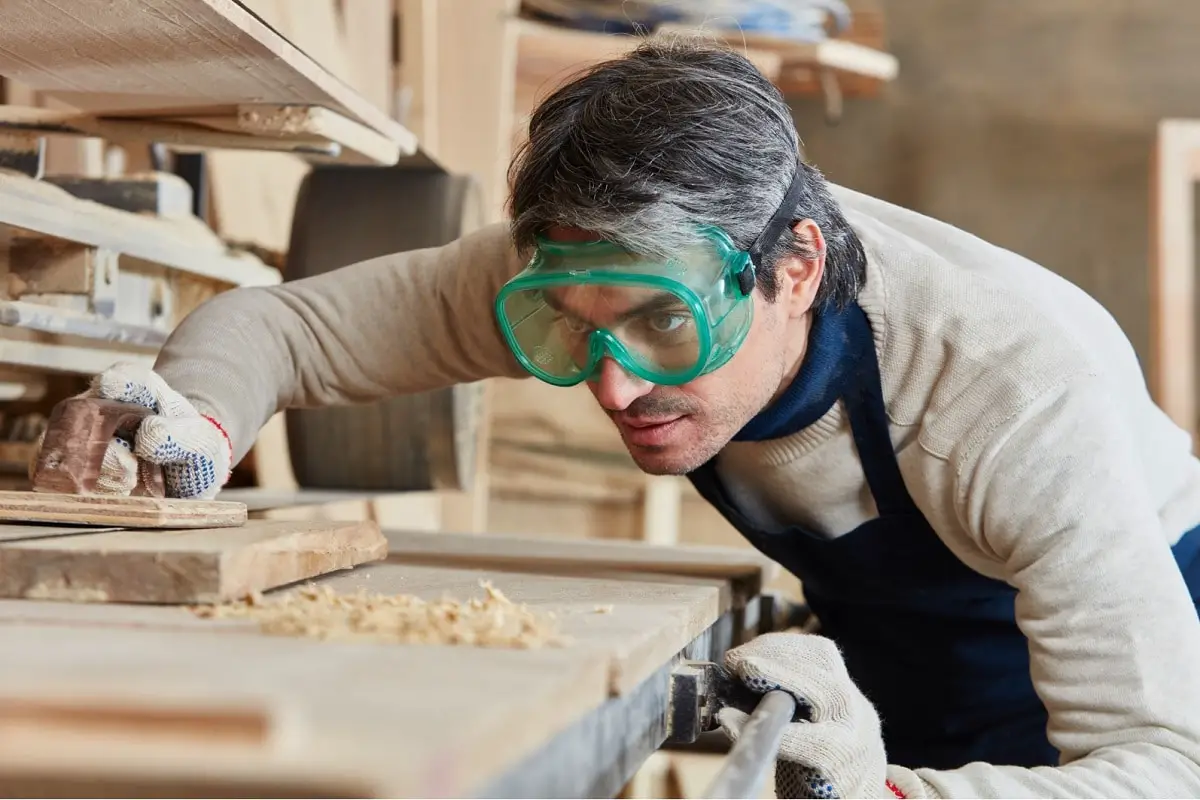You may not think cleaning your safety glasses is too important, but minor vision limitations can lead to significant consequences during a shop incident. You always want to make sure you can see as well as possible when working with woodshop tools and debris.
Germs are another factor and can be spread by touching safety glasses that another person wore. Making sure they are clean and disinfected can keep you safe. The cleaning process is not hard to do and can be done quite quickly.
Cleaning The Lenses
#1 Remove your work gloves first and wash your hands before taking off your woodworking safety glasses. Also, do not wipe your glasses with your t-shirt or shop apron.
#2 Blow away any dust or debris before touching the glasses with cloth or chemicals. This will remove much of the scratch causing material.
#3 Use a drop of dish soap rubbed between your finger tips. You can use any mild dish detergent brand, such as Palmolive, Meyers etc.
#4 Rinse your woodworking safety glasses in a lens cleaning station (if available), under the faucet water, or by using a lens cleaning spray. You can also use dry lens cleaning wipes to remove dust and stains.
#5 After rinsing with water or lens cleaning solution, use a microfiber cloth to dry the lens and remove any remaining streaks.
# 6 Set the safety glasses aside to dry before wearing them again. This can be done on break or at the end of a workday.

Cleaning The Frames
The frames will likely have built-up dust or material if they have not been cleaned in a long time. This can scratch them or end up on the lens. If you wear makeup, this can also build up over time as the glasses rub against the cheeks and temples. Sweat and salt in the skin can dry out the frames if left on them for too long without cleaning. This can compromise the frames and make them more susceptible to breaking.
How to clean the frames:
#1 Using a dry cloth, toothbrush, or toothpick, clean the frames by removing any built-up dust or particles. Make sure to get into the nooks and crannies of the joints.
#2 Rinse the frames under a faucet or spray with a lens cleaning solution.
#3 Wipe the frames with a microfiber cloth and set out to dry.
What To Use To Clean Woodworking Safety Glasses
You can use the following to clean your woodworking safety glasses:
- Microfiber cloth or pouch
- Warm faucet water (But not too hot!)
- Lens cleaning solution
- Toothbrush or toothpick (for the frame and joints)
- Lens cleaning station
- Dish soap run between fingers
What NOT To Use To Clean Woodworking Safety Glasses
Never use cloth material that is abrasive such as shop rags, t-shirts, or towels to clean woodworking safety glasses. Always use only a safety glasses cleaning cloth and solution. Even though this may be inconvenient, it can save you time and money in the long run.
Never use the following to clean your woodworking safety glasses:
- Handsoaps
- Window cleaner
- House or floor cleaners
- Old microfiber wipes with built-up dust
- T-shirts or shop rags
Safety glasses have an anti-fog coating that can be harmed by certain chemicals in soaps, so avoid these when possible.
How To Avoid Scratching The Lens While Cleaning
Safety eyewear is usually made of polycarbonate material. This is very good at withstanding impacts from debris but is also prone to scratching. Much of the scratches on eyewear is the result of improper cleaning practices. Be careful not to press too hard when you wipe or rub the lenses during cleaning. Always remove debris gently by sliding a microfiber cloth across the lens with little pressure.
How NOT To Clean Woodworking Safety Glasses
The main way to ruin safety glasses (besides dropping or crushing them) is to scratch them while cleaning. Do not use any abrasive material to wipe them and always be gentle.
Clean Your Woodworking Safety Glasses Regularly
You can set a time of the day where you wash your safety glasses when finished with your work. If you make it a routine, it will not be a hassle to do and will keep your safety glasses in tip-top shape.
